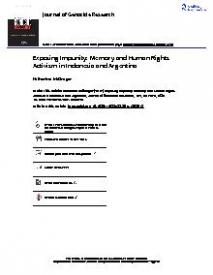Exposing Impunity : Memory and Human Rights Activism in Indonesia and Argentina
This article examines the impact of a new sustained focus in Indonesian human rights activism on connecting historical experiences of violence to ongoing impunity, in order to assess what forms of memory activism are effective in breaking a justice impasse. It does so by using the much more successful case of Argentinian human rights activism for justice for the 1976–83 repression as a point of comparison.
Soon after the end of authoritarian rule, Argentinians held a truth commission and trials of key military leaders. Then, following a period of stalled justice, activists were able to create a new societal consensus on the need for further redress including extended trials. In Indonesia, meanwhile, a proposed truth commission was abandoned and there have been no trials of military leaders, and no other forms of redress initiated by the government for this case. Despite the limitations of almost all justice measures in fully addressing past human rights crimes, the lack of use of any measures acceptable to victims of the violence signals that the Indonesian government does not consider such cases pressing enough. In order to assess how activists might move such cases back onto a national agenda, my analysis focuses on the Argentinian group H.I.J.O.S. (Hijos por la Identidad y la Justicia contra el Olvido y el Silencio/Children for Identity and Justice against Forgetting and Silence), whose members led a successful campaign for a resumption of trials.
I compare the similar emphasis in their activism on exposing impunity to that in the work of the Indonesian group KKPK (Koalisi Keadilan dan Pengungkapan Kebenaran/Coalition for Justice and Truth). I assess their efforts alongside the different political contexts of both countries, arguing that a focus on impunity may be crucial in cracking impasses in justice measures.
Geachte bezoeker,
De informatie die u nu opvraagt, kan door psychotraumanet niet aan u worden getoond. Dit kan verschillende redenen hebben,
waarvan (bescherming van het) auteursrecht de meeste voorkomende is. Wanneer het mogelijk is om u door te verwijzen naar de bron
van deze informatie, dan ziet u hier onder een link naar die plek.
Als er geen link staat, kunt u contact opnemen met de bibliotheek,
die u verder op weg kan helpen.
Met vriendelijke groet,
Het psychotraumanet-team.
In: Journal of Genocide Research, ISSN 1462-3528 ; eISSN 1469-9494 | 19 | 4 | 551–573
https://doi.org/10.1080/14623528.2017.1393948
This is an Open Access article distributed under the terms of the Creative Commons Attribution License (http://creativecommons.org/


